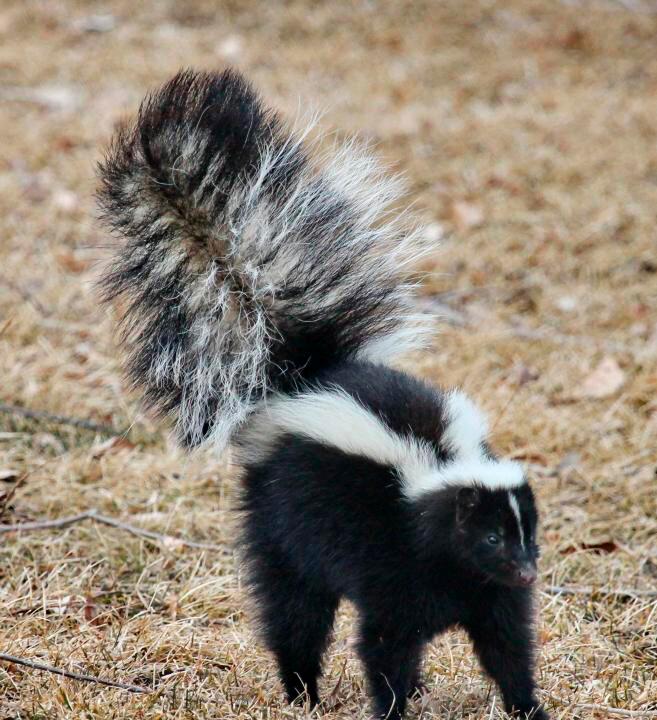Buddy is a New York City dog, accustomed to bedtime walks around the block on a leash. But on family vacations in rural Maine, I let her out the back door each night unaccompanied.
One night last summer, she was gone awhile. I called to her and when she finally stumbled back, she seemed stunned. Her fur and face glistened in the dark.
Then the sickening, unmistakable odor hit. She'd been sprayed by a skunk.
It was late and we were miles from stores that sell dog shampoo or even tomato juice, which I vaguely recalled hearing was a remedy. But my sister found a simple recipe online using ingredients we had: a quart of 3 percent hydrogen peroxide, a quarter-cup baking soda, and a teaspoon or two of liquid soap.
We kept Buddy outside while applying the solution to her fur. The smell immediately dissipated.
I became curious about this miraculous antidote for one of the most unbearable smells on earth. Here’s what I learned.
A Chemist’s Tale
In 1993, chemist Paul Krebaum was working for Molex, a manufacturer headquartered in Illinois, when he developed a substance with odors that were “not appreciated by others in the building,” as he recounts on his website. Krebaum devised a compound to neutralize the smell, and created a gentler version—the skunk remedy—when a colleague’s cat was skunked.
He sent the story to Chemical & Engineering News. It was later reported by the Chicago Tribune. He’s been getting thank-you letters ever since, along with thousands of hits on his website.
He’s rightly proud of the formula: It’s cheap, biodegradable, and ecofriendly. A “Mythbusters” show even confirmed its effectiveness.
William F. Wood, emeritus professor of chemistry at Humboldt State University in Arcata, California, helped popularize the recipe by posting it on another site. He gave Krebaum credit, but got nearly a half-million hits.
In an interview, Krebaum said he never patented or sold the formula, partly because the solution can’t be stored; it must be fresh to work. He could have developed a solid version, but wasn’t interested in marketing. “I like inventing things,” he said.
Skunk Spray Science
Skunk stink comes from a family of sulfur molecules called thiols. Hydrogen peroxide or bleach changes the molecule “to something that does not stink” by oxidizing it, said Theodore Stankowich, assistant professor at California State University, Long Beach, who runs a lab that studies skunk behavior.
Krebaum’s “hydrogen peroxide formula is the best one that I’ve ever seen,” said Stankowich. “I’ve used it on my hands after I'd been sprayed. It immediately took away the scent.”
And don’t bother with tomato juice. “The reason people use (tomato juice) is because the nose is suffering from olfactory fatigue,” Jerry Dragoo, who studies skunks in his work as a mephitologist at the University of New Mexico, explained, citing research by Wood. “Tomato juice will temporarily overwhelm the skunk smell. However, when you go outside to get a breath of fresh air and then come back in, all you smell is skunk.”
Skunk Behavior
“Skunks are nocturnal, but more likely to be out in the evening and early morning,” said Dragoo.
They like “edge habitat,” with brush, vegetation, and burrows next to open space, said Stankowich.
Skunks are omnivores. They'll dig for beetles, worms, and grubs, but also love human trash—including dog and cat food in bowls left outside, Stankowich said.
Leashing your dog in places and at times of day when skunks are active — dawn, dusk, after dark — can reduce the risk of encounters.
Dog Behavior
Stankowich says many predator mammals avoid skunks. Coyotes, wolves and mountain lions have been known to retreat if they encounter one.
Skunks typically issue warnings before spraying. “They will charge you, hiss at you, stick their tail in the air—a whole suite of behaviors warning you not to come near,” Stankowich said. “They do not want to spray you.”
But dogs—clueless as they can sometimes be—just “aren’t receptive” to skunk signals, he said. Whatever instincts their wolf ancestors had to avoid skunks have been lost over generations of domestication.
Stankowich’s lab is researching whether different dog breeds respond differently to skunks. “Some dogs get sprayed once,” he said. “Some never learn.”
Warnings and Advice
Hydrogen peroxide may bleach your dog’s fur. Also, use a washcloth to apply the magic formula to your dog’s face, being careful to keep it away from the eyes. Hydrogen peroxide “can cause corneal ulcers,” said Dragoo.





